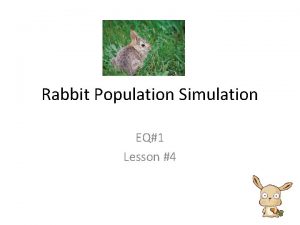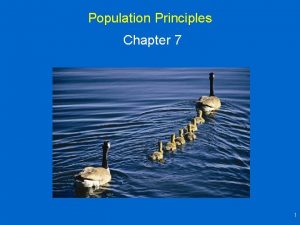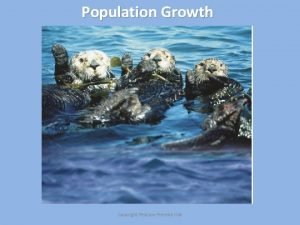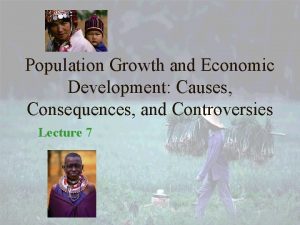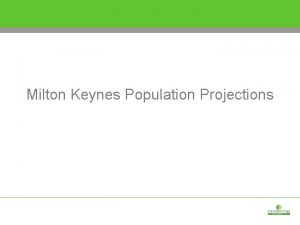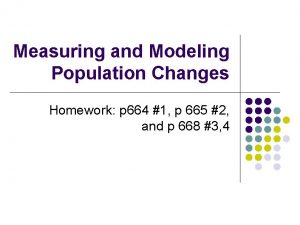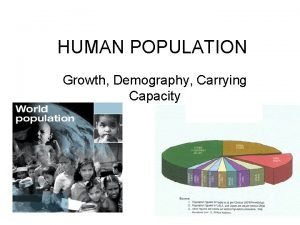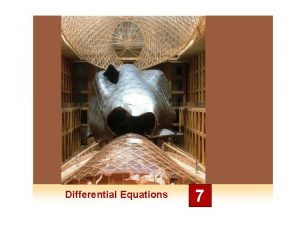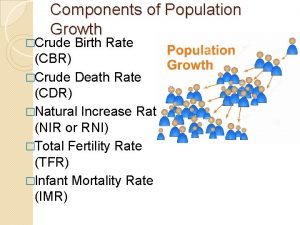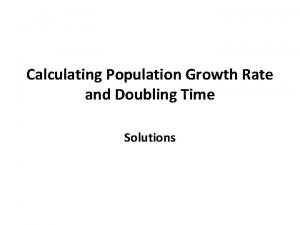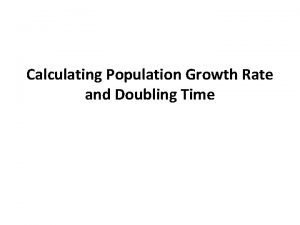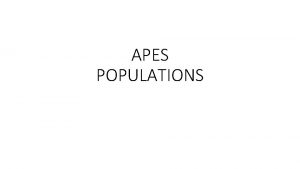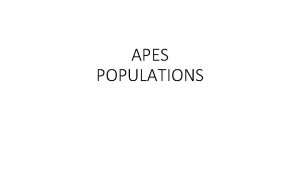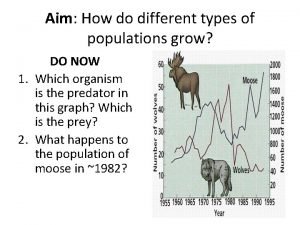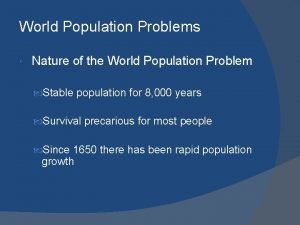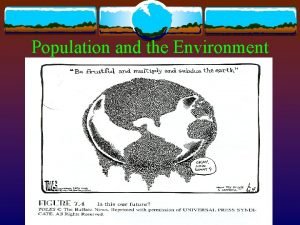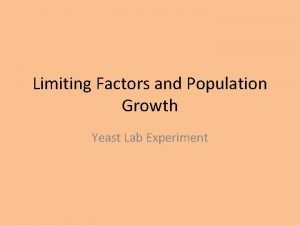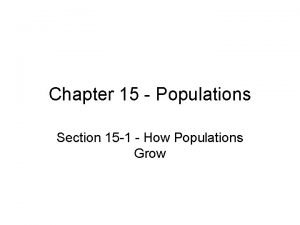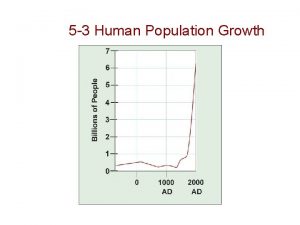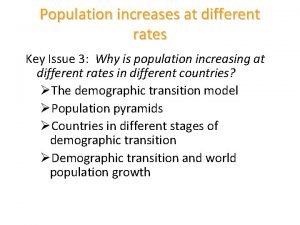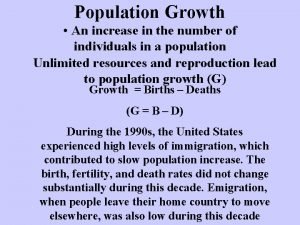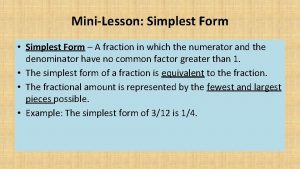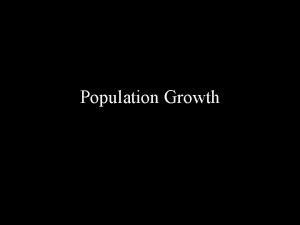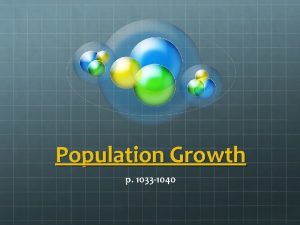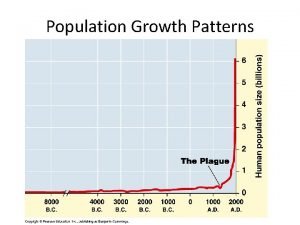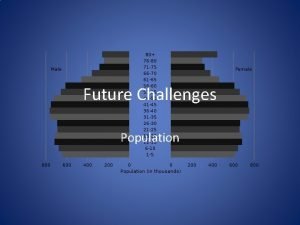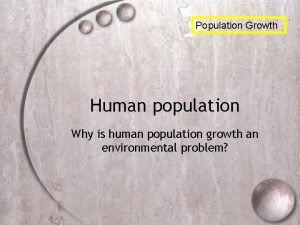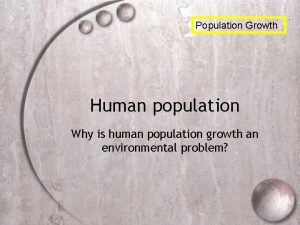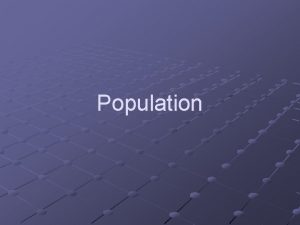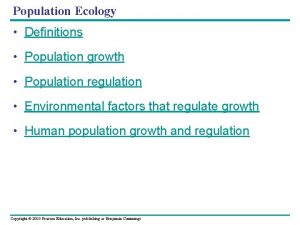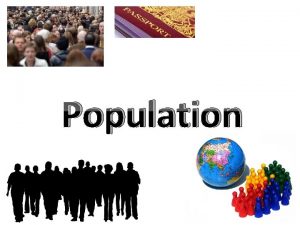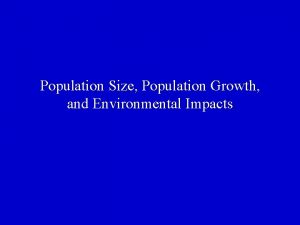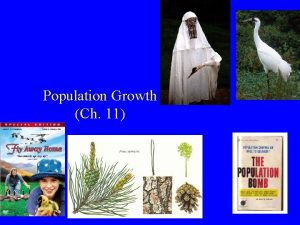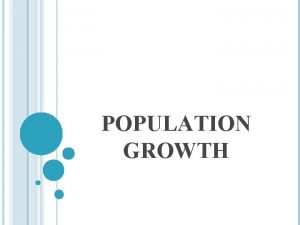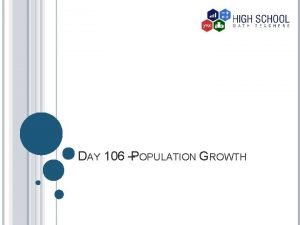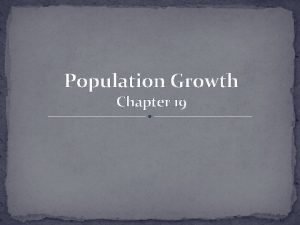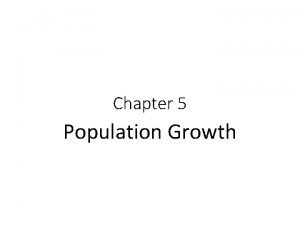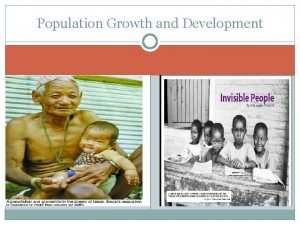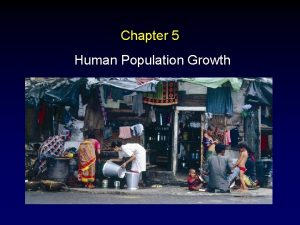Population growth The simplest model of population growth



































- Slides: 35

Population growth

The simplest model of population growth What are the assumptions of this model?

We already saw that the solution is: N t r determines how rapidly the population will increase

A ‘test’ of the exponential model: Pheasants on Protection Island • Abundant food resources • No bird predators Exponential prediction • No migration • 8 pheasants introduced in 1937 Observed By 1942, the exponential model overestimated the # of birds by 4035

Where did the model go wrong? Assumptions of our simple model: 1. No immigration or emigration 2. Constant r - No random/stochastic variation - Constant supply of resources 3. No genetic structure (all individuals have the same r) 4. No age or size structure

Stochastic effects In real populations, r is likely to vary from year to year as a result of random variation in the per capita birth and death rates, b and d. This random variation can be generated in two ways: 1. Demographic stochasticity – Random variation in birth and death rates due to sampling error in finite populations 2. Environmental stochasticity – Random variation in birth and death rates due to random variation in environmental conditions

I. Demographic stochasticity Imagine a population with an expected per capita birth rate of b = 2 and an expected per capita death rate of d = 0. In an INFINITE population, the average value of b is 2, even though some individuals have less than 2 offspring per unit time and some have more.

I. Demographic stochasticity But in a FINITE population, say of size 2, this is not necessarily the case! Here, b = 2. 5 (different from its expected value of 2) solely because of RANDOM chance!

I. Demographic stochasticity Imagine a case where females produce, on average, 1 male and 1 female offspring. In an INFINITE population the average value of b = 1, even though some individuals have less than 1 female offspring per unit time and some have more ΔN=0

I. Demographic stochasticity But in a FINITE population, say of size 2, this is not necessarily the case! If the finite population were just these two Here, b =. 5 (different from its expected value of 1) solely because of RANDOM chance!

II. Environmental stochasticity • r is a function of current environmental conditions • Does not require FINITE populations Source: Anderson, J. J. 1995. Decline and Recovery of Snake River Salmon. Information based on the CRi. SP research project. Testimony before the U. S. House of Representatitives Subcommittee on Power and Water, June 3.

How important is stochasticity? An example from the wolves of Isle Royal (Vucetich and Peterson, 2004) • No immigration or emigration • Wolves eat only moose • Moose are only eaten by wolves

How important is stochasticity? An example from the wolves of Isle Royal • Wolf population sizes fluctuate rapidly • Moose population size also fluctuates • What does this tell us about the growth rate, r, of the wolf population?

How important is stochasticity? An example from the wolves of Isle Royal Frequency The growth rate of the wolf population, r, is better characterized by a probability distribution with mean, , and variance, . Growth rate, r What causes this variation in growth rate?

How important is stochasticity? An example from the wolves of Isle Royal The researchers wished to test four hypothesized causes of growth rate variation: 1. Snowfall (environmental stochasticity) 2. Population size of old moose (environmental stochasticity? ) 3. Population size of wolves 4. Demographic stochasticity To this end, they collected data on each of these factors from 1971 -2001 So what did they find?

How important is stochasticity? An example from the wolves of Isle Royal Cause Percent variation in growth rate explained Old moose ≈42% Demographic stochasticity ≈30% Wolves ≈8% Snowfall ≈3% Unexplained ≈17% (Vucetich and Peterson, 2004) • In this system, approximately 30% of the variation is due to demographic stochasticity • Another 45% is due to what can perhaps be considered environmental stochasticity. *** At least for this wolf population, stochasticity is hugely important***

Practice Problem: You have observed the following pattern Lake 1 e Lak X Lake 2

In light of this phylogenetic data, how to you hypothesize speciation occurred? Lake X Lake 1 Lake 2

A scenario consistent with the data Lake 1 e Lak X Lake 2

A scenario consistent with the data Lake 1 e Lak X Lake 2

A scenario consistent with the data Lake 1 e Lak X Lake 2

Predicting population growth with stochasticity Frequency Stochasticity is important in real populations; how can we integrate this into population predictions? Growth rate, r In other words, how do we integrate this distribution into:

Let’s look at a single population Imagine a population with an initial size of 10 individuals and an average growth rate of r =. 01 In the absence of stochasticity, our population would do this N t The growth of this population is assured, there is no chance of extinction

But with stochasticity… we could get this Vr = 0 Vr =. 0025 r N t t

Or this Vr = 0 Vr =. 0025 r N t t

Or even this… Vr = 0 Vr =. 0025 r N t t

Integrating stochasticity Generation 1: Draw r at random calculate the new population size Generation 2: Draw r at random calculate the new population size. . . and so on and so forth The result is that we can no longer precisely predict the future size of the population. Instead, we can predict: 1) the expected population size, and 2) the variance in population size. Lets illustrate this with some examples…

Comparing two cases Frequency Case 1: No stochasticity ( ) N r t ) Frequency Case 2: Stochasticity ( N r 95% of values lie in the shaded area t

What if the variance in r is increased? Frequency Case 1: No stochasticity ( ) N r t Case 2: Stochasticity ( ) Frequency 95% of values lie in the shaded area N r t

How can we predict the fate of a real population? • What kind of data do we need? • How could we get this data? • How do we plug the data into the equations? • How do we make biological predictions from the equations?

A hypothetical data set Replicate r 1 0. 10 2 0. 15 3 0. 05 4 0. 00 5 -0. 05 6 -0. 02 7 0. 05 8 -0. 08 9 0. 02 10 -0. 05 Wolverine (Gulo gulo) The question: How likely it is that a small (N 0 = 46) population of wolverines will persist for 100 years without intervention? The data: r values across ten replicate studies

Calculation and Vr Replicate r 1 0. 10 2 0. 15 3 0. 05 4 0. 00 5 -0. 05 6 -0. 02 7 0. 05 8 -0. 08 9 0. 02 10 -0. 05 Vr = ?

Using estimates of and Vr in the equations

Translating the results back into biology OK, so what do these numbers mean? Frequency • Remember that, for a normal distribution, 95% of values lie within 1. 96 standard deviations of the mean • This allows us to put crude bounds on our estimate for future population size • What do we conclude about our wolverines? N 100 95% of values lie between these arrow heads

Practice Problem Replicate r 1 0. 05 2 0. 17 3 0. 01 4 0. 00 5 -0. 07 6 -0. 04 7 0. 01 8 -0. 08 9 0. 02 10 -0. 07 Wolverine (Gulo gulo) The question: How likely it is that a small (N 0 = 36) population of wolverines will persist for 80 years without intervention? The data: r values across ten replicate studies
 What is exponential growth in ecology
What is exponential growth in ecology Section 1 population dynamics answer key
Section 1 population dynamics answer key Population ecology section 1 population dynamics
Population ecology section 1 population dynamics Population ecology section 1 population dynamics
Population ecology section 1 population dynamics Chapter 4 section 1 population dynamics
Chapter 4 section 1 population dynamics Rule of 70 in population growth
Rule of 70 in population growth What are the two types of population growth
What are the two types of population growth Modeling population growth rabbits answer key
Modeling population growth rabbits answer key Population growth curve
Population growth curve Population growth factors
Population growth factors Geometric exponential growth
Geometric exponential growth Why population growth is good
Why population growth is good What is population ecology
What is population ecology Exponential population growth
Exponential population growth Population of milton keynes 2021
Population of milton keynes 2021 Types of population growth
Types of population growth Why environmental science is an interdisciplinary science
Why environmental science is an interdisciplinary science Age structure diagram slow growth
Age structure diagram slow growth Factors affecting population explosion
Factors affecting population explosion Linear differential equation
Linear differential equation How to calculate annual population growth rate
How to calculate annual population growth rate Military base population pyramid
Military base population pyramid How to calculate population growth rate
How to calculate population growth rate Population doubling time
Population doubling time R-strategist definition
R-strategist definition Rule of 70 in population growth
Rule of 70 in population growth What are the two types of population growth
What are the two types of population growth Importance of population growth
Importance of population growth World population by age
World population by age Geometric vs arithmetic growth
Geometric vs arithmetic growth Yeast population growth lab
Yeast population growth lab Population growth concept map
Population growth concept map Exponential growth curve of a hypothetical population
Exponential growth curve of a hypothetical population 5-3 human population growth
5-3 human population growth Key issue 3 why does population growth vary among regions
Key issue 3 why does population growth vary among regions Population growth means
Population growth means







